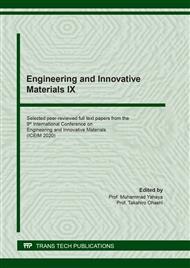[1]
Moore, A.L. and Shi, L., Emerging challenges and materials for thermal management of electronics, Materials today, vol. 17, no. 4, (2014), pp.163-174.
DOI: 10.1016/j.mattod.2014.04.003
Google Scholar
[2]
Chung, D.D.L., Thermal interface materials, Journal of Materials Engineering and Performance, 10(1), (2001), pp.56-59.
Google Scholar
[3]
J.P. Gwinn, R.L. Webb, Performance and testing of thermal interface materials, Microelectron. J. 34 (3) (2003), pp.215-222.
Google Scholar
[4]
Sartre, V. and Lallemand, M. Enhancement of thermal contact conductance for electronic systems. Applied thermal engineering, 21(2), (2001), pp.221-235.
DOI: 10.1016/s1359-4311(00)00034-x
Google Scholar
[5]
Prasher, R., Thermal interface materials: historical perspective, status, and future directions. IEEE, 94(8), (2006), pp.1571-1586.
DOI: 10.1109/jproc.2006.879796
Google Scholar
[6]
H. Chen, H. Wei, M. Chen, F. Meng, H. Li, Q. Li, Enhancing the effectiveness of silicone thermal grease by the addition of functionalized carbon nanotubes, Appl. Surf. Sci. 283, (2013), pp.525-531.
DOI: 10.1016/j.apsusc.2013.06.139
Google Scholar
[7]
R. Viswanath, V. Wakharkar, A. Watwe, V. Lebonheur, Thermal performance challenges from silicone to systems, Intel. Technol. J., (2000), pp.1-16.
Google Scholar
[8]
Y. Xu, D.D.L. Chung, C. Mroz, thermally conducting aluminum nitride polymer-matrix composites, Compos. Part A Appl. Sci. Manuf. 32 (12), (2001), pp.1749-1757.
DOI: 10.1016/s1359-835x(01)00023-9
Google Scholar
[9]
W. Zhou, D. Yu, C. Wang, Q. An, S. Qi, Effect of filler size distribution on the mechanical and physical properties of alumina-filled silicone rubber, Polym. Eng. Sci. 48 (7), (2008) pp.1381-1388.
DOI: 10.1002/pen.21113
Google Scholar
[10]
J. S. Oh, J. H. Park, W. W. Kim, C. K. Rhee, tribological properties of Cu-Ni alloy nano powders synthesized by pulsed wire evaporation(PWE) Method, Journal of Korean powder metallurgy institude, Vol. 11, No. 5, (2004), pp.376-382.
DOI: 10.4150/kpmi.2004.11.5.376
Google Scholar
[11]
J. Park, G. Jeong, Y. Kim, K. Kim, C. K. Lee, A study on corrosion resistance and electrical surface conductivity of an electrodeposited Ni-W thin film, J. Kor. Inst. Surf. Eng, Vol 44, No. 2, (2011), pp.68-73.
DOI: 10.5695/jkise.2011.44.2.068
Google Scholar
[12]
J. Y. Lee, S. B. Yim, M. Kim, Y. Jeong, Spectroscopic and electrochemical study on the citrate-based CuNi codeposition, J. Kor. Inst. Surf. Eng, Vol 44, No. 3, (2011), pp.117-123.
Google Scholar
[13]
Peñas, J.R.V., Ortiz de Zarate, J. M. and Khayet, M. Measurement of the thermal conductivity of nanofluids by the multicurrent hot-wire method. Journal of Applied Physics, 104(4), (2008).
DOI: 10.1063/1.2970086
Google Scholar
[14]
Nagasaka, Yuji, and A. Nagashima. Absolute measurement of the thermal conductivity of electrically conducting liquids by the transient hot-wire method., Journal of Physics E: Scientific Instruments 14.12, (1981).
DOI: 10.1088/0022-3735/14/12/020
Google Scholar
[15]
D. J. Cumberland, R. J. Crawford, Handbook of Powder Technology, in: The Packing of Particles, vol. VI, Elsevier Science, Amsterdam, (1987).
Google Scholar
[16]
Wei Yu, Huaqing Xie, Luqiao Yin, Junchang Zhao, Ligang Xia, Lifei Chen, Exceptionally high thermal conductivity of thermal grease: Synergistic effects of graphene and alumina, International Journal of Thermal Sciences 91, Elsevier Science, Amsterdam, (2015), pp.76-82.
DOI: 10.1016/j.ijthermalsci.2015.01.006
Google Scholar


